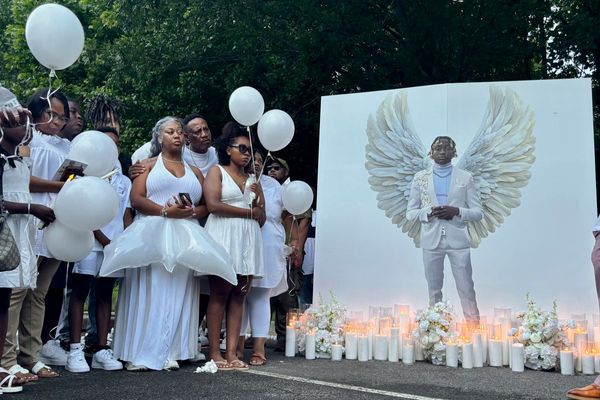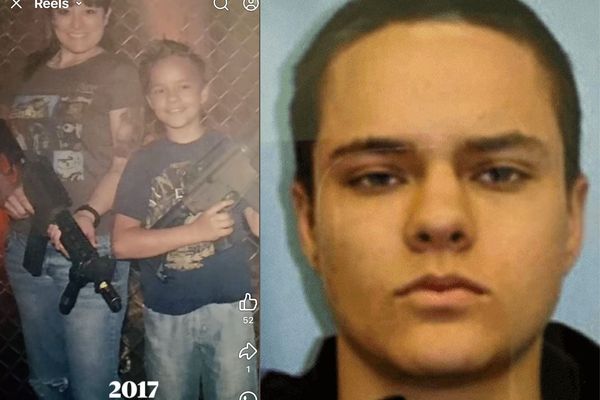
Police in the US use force on at least 300,000 people each year, injuring an estimated 100,000 of them, according to a groundbreaking data analysis on law enforcement encounters.
Mapping Police Violence, a non-profit research group that tracks killings by US police, launched a new database, policedata.org, on Wednesday cataloging non-fatal incidents of police use of force, including stun guns, chemical sprays, K9 dog attacks, neck restraints, beanbags and baton strikes.
The database features incidents from 2017 through 2022, compiled from public records requests in every state. The findings, the group says, suggest that despite widespread protests against police brutality following the murder of George Floyd in 2020, overall use of force has remained steady since then – and in many jurisdictions, has increased.
The data builds on past reports that found US police kill roughly 1,200 people each year, or three people a day, a death toll that has crept up every year and dramatically exceeds rates in comparable nations. The nonfatal force statistics and accompanying report illustrate how the killings are just a small fraction of broader police violence and injuries caused by law enforcement.
In the absence of a national tracking system for use of force, Mapping Police Violence said it obtained data on use-of-force incidents from more than 2,800 agencies, covering nearly 60% of the population, and got six full years of data from 634 of those departments. The organization calculated average rates of force by population to get its national estimates. The data is considered an undercount as it only covers incidents disclosed by officers and agencies, and many states have laws restricting access to police files.
Here are some key findings:
Thousands of people are hit with stun guns and chemical sprays
Of the agencies that disclosed data for 2022, representing roughly half of the country, Mapping Police Violence found there were 1.2 uses of force reported for every 1,000 residents. The most common use of force was stun guns, which are considered “less-lethal” but can also have deadly consequences; the organization tracked more than 20,000 stun gun deployments.
In 2022, the group also cataloged more than 8,000 incidents of chemicals being sprayed; more than 4,700 cases of people hit by weapons like batons and beanbags; and more than 2,100 cases of contacts with K9 dogs.
Some uses of chemicals and “less-lethal” weapons come from police protest responses, with the organization’s data showing a spike in these encounters during the George Floyd protests.
The group also estimated that along with the 300,000 use-of-force cases each year, there are an additional 200,000 cases in which officers threaten force.
Mapping Police Violence’s overall estimates are aligned with past research. A US Bureau of Justice Statistics survey of citizens from 2002 to 2011 estimated that an average of 350,000 people reported facing physical force by police each year. A law enforcement consulting firm recently estimated 400,000 use-of-force incidents each year.
Many people subject to police force are unarmed
Thirty-one agencies disclosed whether people were armed when they faced police force. On average, 83% of people subjected to force across those jurisdictions were unarmed, the agencies reported.
Thirteen agencies disclosed information on what preceded the encounter. In those jurisdictions, fewer than 40% of use-of-force incidents originated with reports of violence or involved a violent crime charge. This mirrors patterns for lethal force, with data suggesting the majority of people killed by police are not accused of violent or serious crimes.
The racial disparities are stark
Black people were subject to overall police use of force at a rate 3.2 times greater than white people in 2022, according to the report. That disparity is more severe than lethal force trends; Black people were killed by police at 2.6 times the rate of white people in 2022.
“The overall scale of the use of nonfatal force is just a different order of magnitude than deadly force,” said Samuel Sinyangwe, Mapping Police Violence’s founder. “It is even more disproportionately Black and more disproportionately unarmed and involved in nonviolent situations. All the inequities we’ve identified about police deadly force appear to be even more extreme in the context of overall police force.”
Limited data also suggests that unhoused people are disproportionately impacted; for the eight agencies that disclosed housing status, 11 to 44% of people subject to force were listed as unhoused.
Half of the agencies reported increases in force since 2020
Half of the agencies reported increases in overall force in the two-year period following Floyd’s murder, the report said. Fewer than one in six agencies reported significant reductions in use of force. Those estimates come from 727 agencies that disclosed at least five years of data, comparing 2018-2019 rates to 2021-2022 rates.
Jurisdictions that increased police budgets were more likely to see increases in use of force, the report found. There were also higher rates of force in agencies with higher arrest rates for low-level offenses, suggesting that departments that aggressively enforce minor infractions could be more likely to attack or injure civilians.
“There is a lack of broad accountability,” said Salimah Hankins, adviser to and former director of the United Nations Antiracism Coalition, which toured cities across the US to document systemic racism in the criminal legal system last year. The group identified “impunity” for police killings, which are rarely prosecuted, as a barrier to reforms. “If you have no real accountability, then why would there be the will to change this?”
The political climate has continued to favor the status quo of law enforcement operations, she added: “We’re in a cycle where the pendulum swings back and forth – 2020 created a heightened awareness, and that awareness is still there. But I do think we’re in a backlash. And it is politically expedient for candidates to be seen as ‘tough-on-crime, law-and-order’ in a way that does throw poor people, Black and brown people, people with disabilities under the bus.”
There were signs of isolated reductions in police violence
Floyd’s murder brought national scrutiny to officers using neck restraints on people in custody, and in 2020, local and state policies proliferated restricting this deadly tactic. Mapping Police Violence found a notable impact: of the 757 agencies that disclosed types of force used over time, there were 973 neck restraint uses in 2019. By 2021, there were 112 of those cases, a nearly 90% drop.
“It shows that policy can make a difference, but overall use of force didn’t change,” Sinyangwe said, explaining that reductions in that specific tactic did not translate to broader declines in police force and killings.
There is also evidence that interventions by the US justice department and state attorneys general could have an impact. Jurisdictions with DoJ reform agreements reported a 22% reduction in overall reported use of force, Mapping Police Violence found. And 13 out of 18 agencies that adopted state or federal reforms reported reductions in use of force.
Policies that reduce overall police encounters can be most effective at reducing injuries and killings by police, such as alternative responder programs dispatching mental health professionals to people in crisis, Sinyangwe said. He said he hoped his database would help officials, including a potential Kamala Harris administration, identify agencies in need of urgent intervention. And he hoped to see an expansion of initiatives shown to work.
“We have a relentless system that has been reproducing these extremely violent outcomes year after year,” he said. “The approach that cities and states took to reduce use of force after George Floyd’s murder was just not aligned to the severity of the problem. The overall goal of making communities safer from police violence has not been achieved.”







